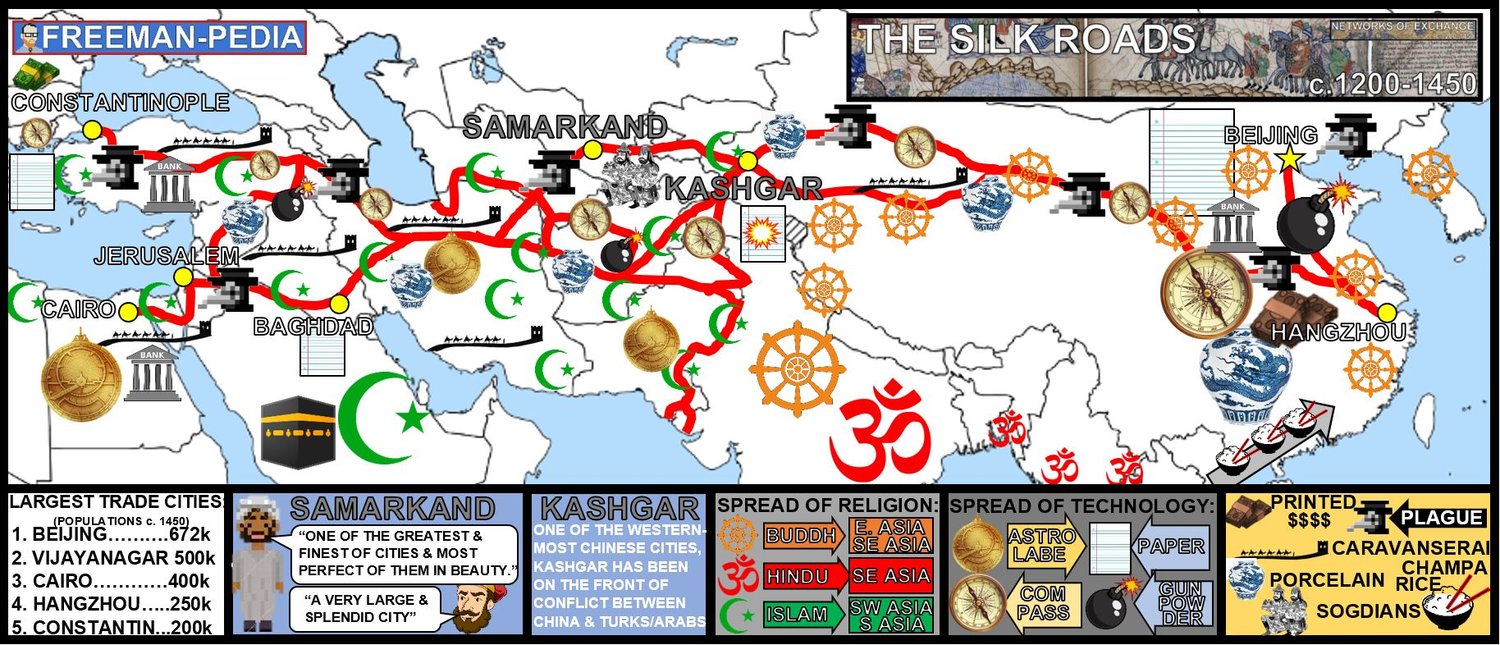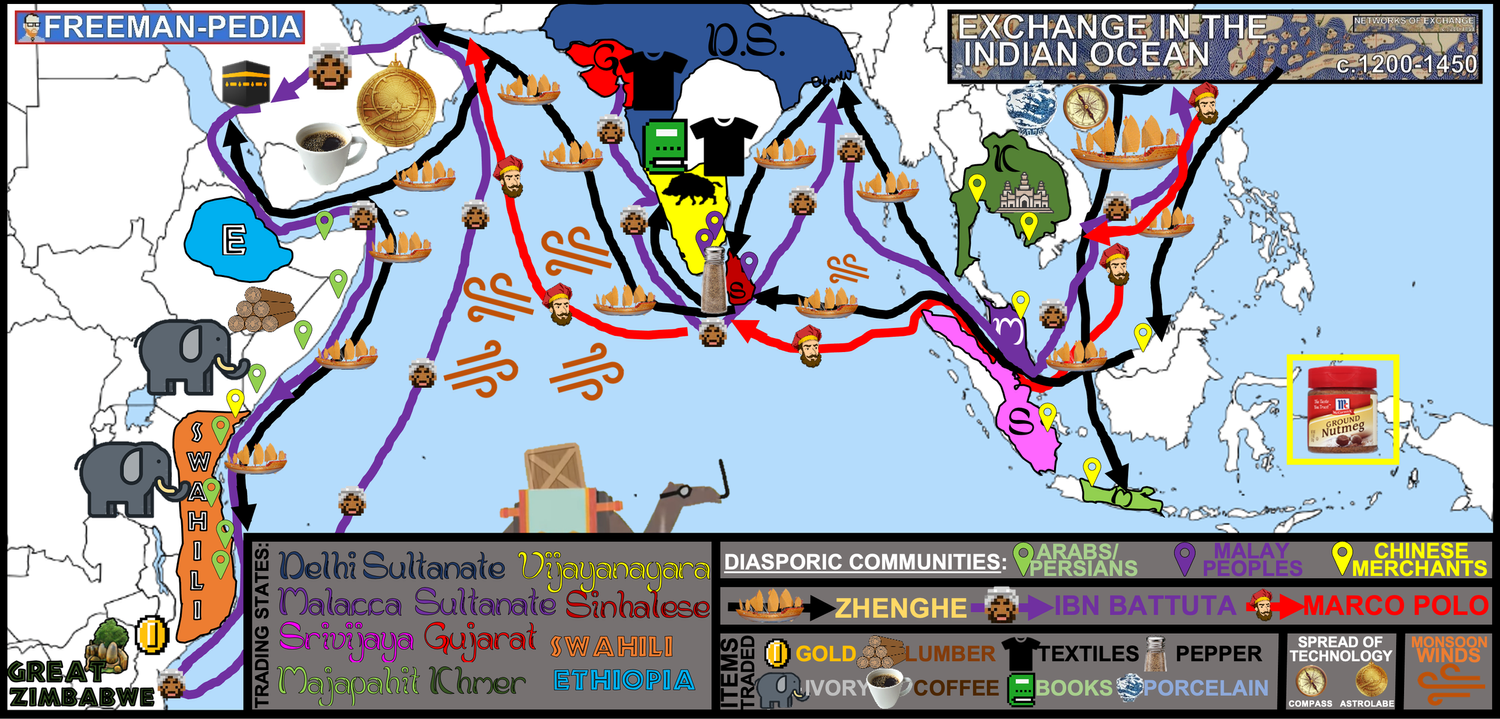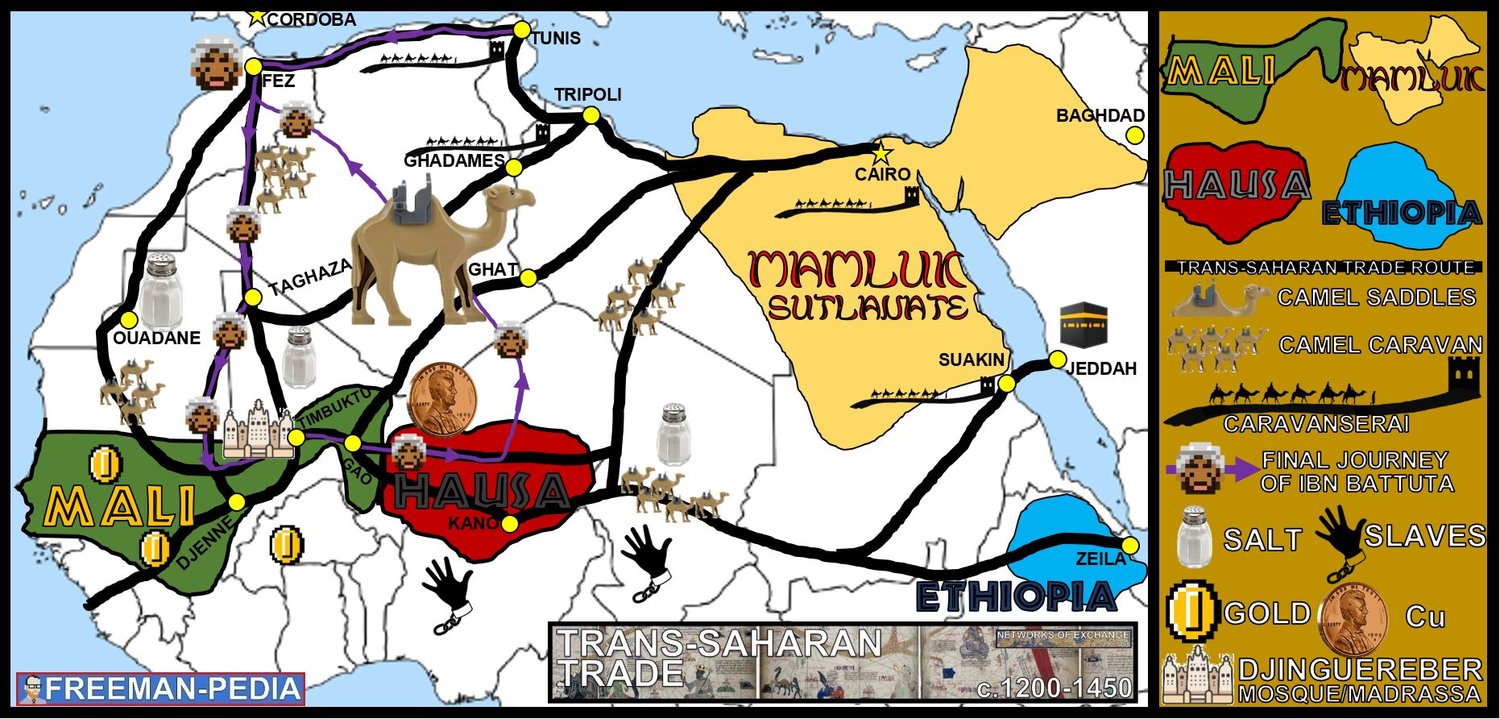Unit 2: Networks of Exchange
Topic 2.1: The Silk Roads

The Silk Road was a network of multiple routes that gradually merged over centuries. Early agricultural nomads spread goods and ideas through trade routes. These early trade routes expanded through conquest into the Silk Roads. Connected nomadic pastoral people in Central Asia with East, South, and Central Asia. Moved mostly luxury groups.
Causes:
Geography: Eurasia has cold and hot places. Cotton cannot grow in some places, so places that cannot grow those plants, needing to trade for it from a faraway place. Cold places trade stuff that only grows in cold with hot, and vice versa.
More powerful empires: Trade along the silk roads flourished when powerful states provided stable and safe environments for merchants to do business. This includes the Byzantine, Abbasid, China’s Tang and Song dynasties, and the Mongol Empire.
Desire for luxury goods: Privileged classes want luxury goods like Chinese silks and Porcelains and diverse foods as status symbols.
New commercial practices and technologies: Easier ways for people to trade, people trade more. Specifically caravanserai, paper money, and banking services.
Effects:
The production of goods expanded: In China, peasants switched from food crops to silk, paper, porcelain, and iron. In India and Persia, artisans expanded the production of cotton and silk textiles.
Merchants wealth and status increased: The power and wealth of merchants increased. Over time, in many societies worldwide, wealthy merchants replaced traditional elites, like large landowners.
Increased Urbanization: Urbanization increased as economies commercialized…
The spread of revolutionary technologies: New tech like gunpowder, paper, and the printing press changed civilizations as they diffused from the areas of their inventions worldwide.
The spread of crops and animals: Crops and animals expanded to new locations. Camels spread from Central Asia to desserts in East and North Africa. Grapes as well.
Spread of beliefs: Buddhism, Islam, and Christianity. Linguistic, Math, and Science also moved.
Disease: The Bubonic Plague killed millions in their path.
Topic 2.3: Exchange in the Indian Ocean

Causes:
New economic practices increased trade, such as banking services like promissory notes and credit, and paper money. Technological innovations increased trade (maritime technologies), such as the magnetic compass, the astrolabe, and new ship designs, such as the dhow ship (Malaysian), junk ship (Chinese), and lateen sails.
Effects:
Cultural diffusion of religion, luxury and normal goods, and the voyages Zheng He.
Dynasties:
Song Dynasty gets rice, which allows pop to increase, and new stuff to increase trade. The Mongols are leaded by Genghis Khan. Grandkid rules China under the Yuan Dynasty. The Han overthrow the Yuan, and make Ming dynasty. Rule by the end of 1450. Make a massive ship fleet to do an excursion across the Indian Ocean. Gets lots of goods and tributaries states. Then he cuts trade from everyone, making the ships useless.
Diasporic Communities:
Arab and Persian Muslim merchants, Chinese merchants, Malaysian merchants, Indian and south Asian merchants. This leads to new trading cities. 4 centers of trade: Guangzhou in China, Malacca in Southeast Asia, Calicut in India, and Kilwa in Swahili.
Monsoon:
Mariners and merchants used knowledge of monsoon winds to move across the Indian Ocean region using sailboats. People started making monsoon maps to predict exactly when to go across the Indian Ocean, to ride the monsoon safely.
Topic 2.4: Trans-Saharan Trade Routes

The main things traded over the Trans-Saharan Trade were gold, salt, and slaves. They got salt because salt helped preserve food (no refrigerators in the 1200s). These are not Europeans coming to buy slaves. These are other Africans or Arab traders that are getting slaves. Most of this stuff is being carried on the back of camels. The camels facilitate trade. Camels aren’t from Egypt. They are from Arabia, and were brought over to the Sahara to transport stuff. New commercial practices and technology increased trade. These technological advances were camels, camel saddles, caravans, and caravanserais. Camel saddle were THE technological innovation that facilitated trade in the Sahara. Caravans were groups of camels travelling together with armed guards. This helped defend against bandits. Caravanserais were like motels over the trans-Saharan trade route that let the camels and merchants rest. This also facilitated for cities around these places.
Effects:
Economic prosperity for the African kingdoms (through increased business, goods being exchanges, and taxes), the spread of the Islamic religion, language, and learning, and the growth of towns, cities, and empires. Small trade places become major cities due to trade coming through the area.
Mali, Hausa, and Songhai used the power of their government to increase trade in West Africa. This created common currencies, built powerful militaries, and built relationships with influential groups.
Mansa Musa
The most wealthy person in human history is Mansa Musa. He ruled the Mali empire. Came to power in 1312. He annexed the city of Timbuktu and the Niger River to gain access to important trade routes between the Mediterranean. Mali has gold and salt, making him rich through trade. He showed this wealth during the pilgrimage to Mecca, where he brings 500 camels as his caravan during it. Also had 10k people with him. Spent lots of gold on his way, in laces such as Cairo. Caused mass inflation in Cairo. After his pilgrimage, he built a huge mosque in Timbuktu, and a major university there. Began first public education system. Also had massive urbanization projects. Both him and Ibn Battuta brought more travelers to West Africa.